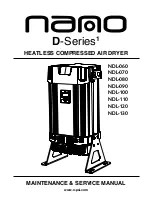
1-800-533-7533
HI-E DRY 195
Installation, Operation and Maintenance Instructions
5
www.QuestProtect.com
quest
Asset Protection and IAQ Solutions
quest
quest
quest
2.1A In Humid Area, No Ducting
The simplest installation is to place the HI-E Dry 195 in the humid area with no ducting. The air inlet on top
& outlet on the side must be at least 1’ from walls and other obstructions to air flow.
2.1B In Humid Area, Duct inlet and/or Outlet
If the humid area is very large or has high ceilings, dehumidification can be improved by adding an inlet
and/or outlet duct to circulate and destratify stagnant areas. For a large area, add inlet or outlet ducting to
create flow across the area’s greatest length.
For areas with ceilings higher than 12’, use an inlet duct to draw warm, moist air from near the ceiling. See
section 2.4 for attaching duct collars & ducting.
2.1C In Remote Area, Duct Inlet & Outlet
It is often desirable, especially in pool rooms and finished areas, to install the HI-E Dry 195 in an adjacent
equipment room or unfinished area. Air is transferred between the humid room and the unit via ducting.
The factory mounted humidity control on the HI-E Dry 195 cabinet may not sense the humidity in the humid
room accurately enough with this installation method. If so, an additional humidity control can be mounted
in the humid room and wired to the HI-E Dry 195. Local electrical codes must be followed when wiring the
control.
2.1D In Remote Area, Duct Outlet Only
A simpler remote installation method than the one above uses ducting only between the HI-E Dry 195
discharge and the humid room; the HI-E Dry 195 inlet draws air from the room in which it’s located. This
works well if there is an adequate air flow path between the two rooms; e.g., high door undercut, louvered
door or wall grill. This eliminates the need to remote mount the humidity control. There are several potential
disadvantages to using this method. First, humid air is drawn into the room where the HI-E Dry 195 is
located. Second, to accurately sense humidity, the blower in the HI-E Dry 195 may need to run continuously
to draw air from the humid room into the HI-E Dry 195 room. Third, a slight negative pressure is created
in the room with the HI-E Dry 195 which could back draft open combustion devices located there. If such
devices are present, call the factory for specific instructions before using this installation method or consider
the option below.
2.1E In Remote Area, Duct Inlet Only
When the HI-E Dry 195 is located in a room separate from the main area to be dehumidified, it may be
desirable to dehumidify and/or slightly pressurize that room. Pressurization assures that open combustion
devices do not back draft as would be the case if the room was sufficiently de-pressurized. This can be
accomplished by installing a duct from the humid room to the HI-E Dry 195 inlet and by allowing the HI-E
Dry 195 to discharge the dehumidified air into the room in which it’s located. An adequate air flow path
must exist between the two rooms for this method to work well. An additional humidity control may need to
be mounted in the humid area and wired to the HI-E Dry 195 to accurately maintain the desired humidity.
Local electrical codes must be followed when wiring the control.
2.2 Electrical Requirements
The HI-E Dry 195 plugs into a common grounded outlet on a 15 Amp circuit. It draws between 6 and 7
Amps under normal operating conditions. If used in a wet area (pool, spa room, or basement prone to
flooding), a ground fault interrupter protected circuit is required.
If an extension cord is required, it must have a minimum of 16 gauge conductors if less than 25 feet long and
14 gauge if greater than 25 feet.



































